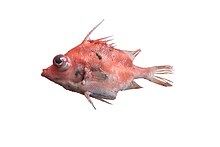
Tetraodontiformes, also known as the Plectognathi, is an order of ray-finned fishes which includes the pufferfishes and related taxa. This order has been classified as a suborder of the order Perciformes, although recent studies have found that it, as the Tetraodontoidei, is a sister taxon to the anglerfish order Lophiiformes, called Lophiodei, and have placed both taxa within the Acanthuriformes. The Tetraodontiformes are represented by 10 extant families and at around 430 species overall. The majority of the species within this order are marine but a few may be found in freshwater. They are found throughout the world.

Brachypterois is a genus of marine ray-finned fishes belonging to the family Scorpaenidae, the scorpionfishes. They are native to the Indian Ocean and the western Pacific Ocean.

Rhinopias is a genus of marine ray-finned fish belonging to the family Scorpaenidae, the scorpionfishes. The species in this genus are found in the Indian and Pacific oceans.
The spotfin scorpionfish is a species of marine ray-finned fish belonging to the family Scorpaenidae, the scorpionfishes. It is known from the western Indian Ocean This species is the only known member of the genus Neoscorpanea.

The spikefishes are ray-finned fishes related to the pufferfishes and triggerfishes. They live in deep waters; more than 50 m (160 ft), but above the continental shelves. They are found in the Atlantic, Indian Ocean, and the west-central Pacific.
Atrophacanthus is a monospecific genus of marine ray-finned fish belonging to the family Triacanthodidae, the spikefishes. The only species in the genus is Atrophacanthus japonicus, the upward-mouth spikefish, which is found in the Indo-West Pacific region.
Bathyphylax is a genus of marine ray-finned fishes belonging to the family Triacanthodidae, the spikefishes. The fishes in this genus are found in the deep waters of the Indian and Pacific Oceans.

Halimochirurgus is a genus of marine ray-finned fishes belonging to the family Triacanthodidae, the spikefishes. The fishes in this genus are found in the deep waters of the Indian and Pacific Oceans.

Hollardia is a genus of marine ray-finned fishes belonging to the family Triacanthodidae, the spikefishes. These demersal fishes are found in the Western Atlantic Ocean with one species being found in the Pacific Ocean.
Johnsonina is a monospecific genus of marine ray-finned fish belonging to the family Triacanthodidae, the spikefishes. The only species in the genus is Johnsonina eriomma, the bullseye spikefish, which is found in the Western Atlantic Ocean.

Macrorhamphosodes, the trumpetsnouts, is a genus of marine ray-finned fishes belonging to the family Triacanthodidae, the spikefishes. The fishes in this genus are found in the deep waters of the Indian and Pacific Oceans.
Mephisto fraserbrunneri, the devil's spikefish, is a species of marine ray-finned fish belonging to the family Triacanthodidae, the spikefishes. This species is found in the Indian Ocean.
Mephisto is a genus of marine ray-finned fishes belonging to the family Triacanthodidae, the spikefishes. These fishes are found in the Indian Ocean.

Parahollardia is a genus of marine ray-finned fishes belonging to the family Triacanthodidae, the spikefishes. These demersal fishes are found in the Western Atlantic Ocean.

Paratriacanthodes is a genus of marine ray-finned fishes belonging to the family Triacanthodidae, the spikefishes. These fishes are found found in the Indian and Pacific Oceans.

Triacanthodes is a genus of marine ray-finned fishes belonging to the family Triacanthodidae, the spikefishes. These fishes are found found in the Indian and Pacific Oceans.

Triacanthoidei is a suborder of ray-finned fishes belonging to the order Tetraodontiformes, which includes the pufferfishes, triggerfishes and related taxa. These benthic fishes are mainly found in the Indian Ocean with some of the spikefishes found in the Western Atlantic Ocean.

Hollardiinae is a subfamily of marine ray-finned fishes belonging to the family Triacanthodidae, the spikefishes. This small subfamily comprises two genera and a total of five species and all, except one species, are found in the tropical and subtropical waters of the Western Atlantic Ocean. The exception is found in the western and central Pacific Ocean.

Triacanthodinae is a subfamily of marine ray-finned fishes belonging to the family Triacanthodidae, the spikefishes. This subfamily comprises nine genera and a total of nineteen species and all, except one species, are found in the tropical and subtropical waters of the Indo-Pacific. The exception is found in the western Atlantic Ocean.
Mephisto albomaculosus, the white spotted spikefish, is a species of marine ray-finned fish belonging to the family Triacanthodidae, the spikefishes. This species is found in the Indian Ocean.









